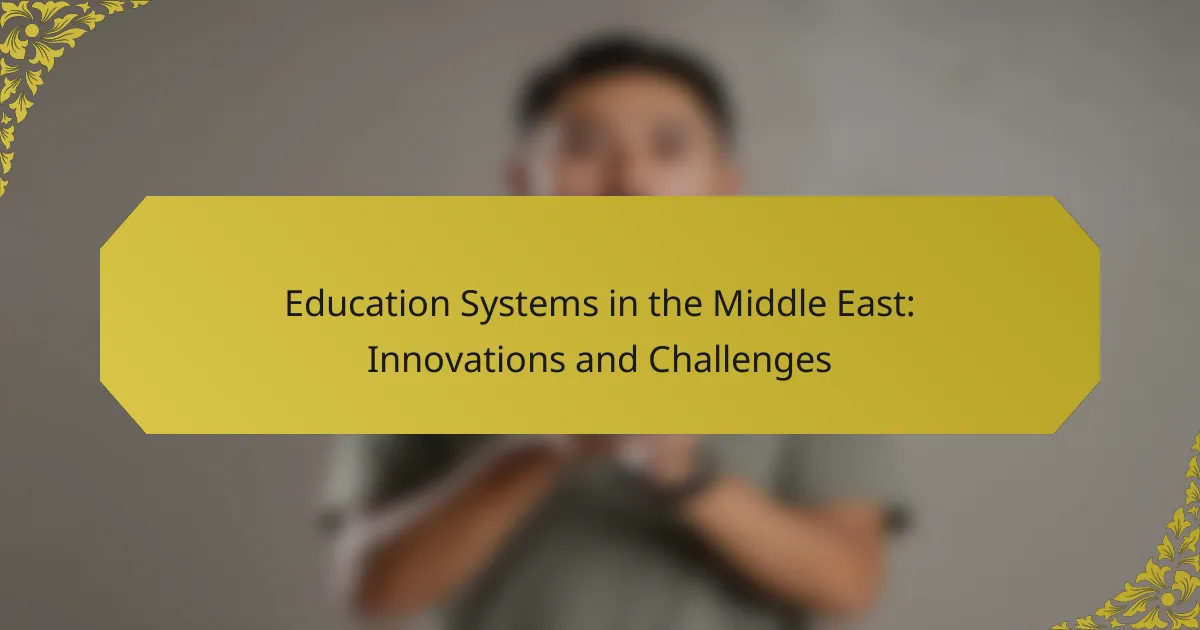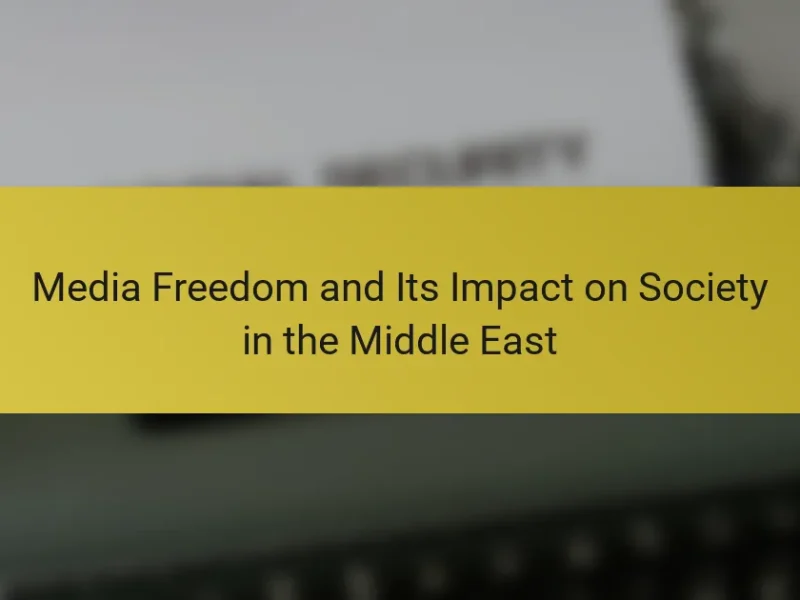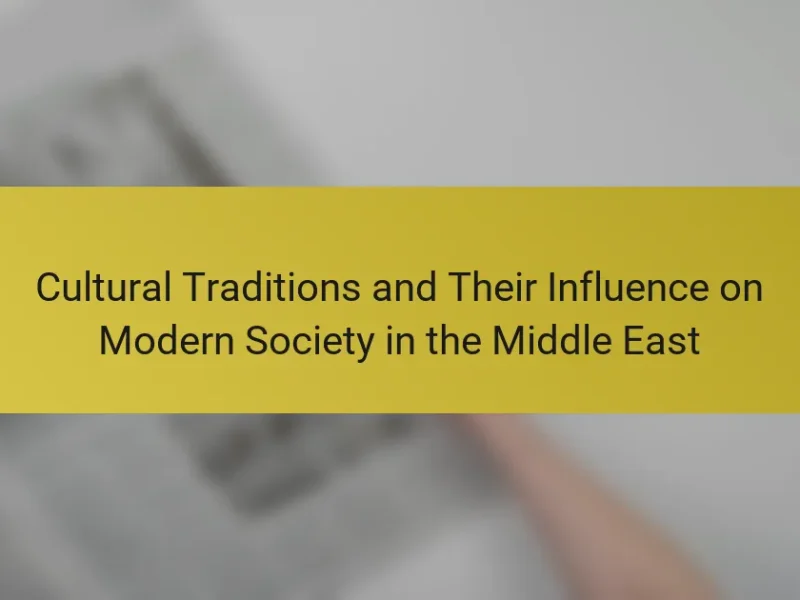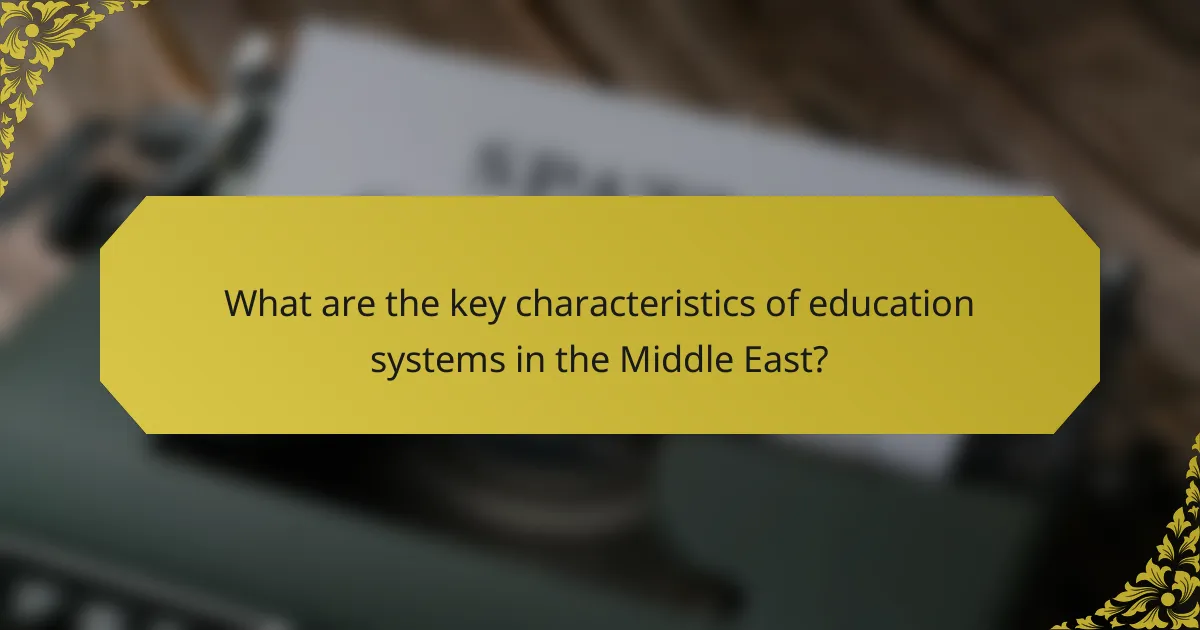
What are the key characteristics of education systems in the Middle East?
Education systems in the Middle East exhibit several key characteristics. They often focus on rote memorization and standardized testing. This approach emphasizes the acquisition of factual knowledge over critical thinking skills. Many countries in the region have a dual education system, incorporating both public and private institutions.
Curriculum content frequently includes a strong emphasis on religious education. This is particularly evident in countries where [censured] plays a central role in society. Additionally, there is a growing trend toward incorporating technology in classrooms. This shift aims to modernize educational practices and improve student engagement.
Teacher qualifications can vary significantly across the region. In some areas, teachers are highly trained, while in others, there may be a shortage of qualified educators. Education policies are often influenced by cultural and socio-economic factors. This leads to disparities in access and quality of education between urban and rural areas.
Overall, the education systems in the Middle East are characterized by a blend of traditional practices and emerging innovations.
How do cultural factors influence education in the Middle East?
Cultural factors significantly influence education in the Middle East. Traditional values shape educational priorities and methods. For instance, respect for authority impacts student-teacher relationships. In many regions, gender roles affect educational access and opportunities. Female education often faces barriers due to cultural perceptions. Religious beliefs also play a critical role in curriculum design. Subjects like Islamic studies are prioritized in many schools. Additionally, family expectations drive students towards specific fields of study. These cultural dimensions create a unique educational landscape in the region.
What role do religious beliefs play in shaping educational practices?
Religious beliefs significantly influence educational practices, especially in the Middle East. They shape curricula, teaching methods, and school governance. For instance, Islamic teachings often dictate the inclusion of religious studies in schools. This integration promotes moral education aligned with religious values. Additionally, religious beliefs impact the scheduling of academic activities around religious observances. Schools may close during significant religious holidays, affecting the academic calendar. Furthermore, the role of religious leaders in educational institutions can guide pedagogical approaches. Research indicates that in countries like Saudi Arabia, education is heavily infused with Islamic principles. This reflects a broader trend where religious frameworks inform educational policies and practices.
How does the socio-economic environment affect access to education?
The socio-economic environment significantly affects access to education. Families with higher income levels can afford educational resources such as books, tutoring, and technology. In contrast, low-income families often struggle to meet basic needs, limiting their ability to invest in education.
Regions with strong economic infrastructure typically have better schools and educational facilities. Conversely, areas with economic instability may lack sufficient schools and qualified teachers.
Research indicates that children from wealthier backgrounds perform better academically than those from disadvantaged backgrounds. According to the World Bank, children in low-income households are 2.5 times more likely to be out of school compared to their wealthier peers.
Additionally, socio-economic factors influence parental involvement in education. Parents with lower socio-economic status may have less time and resources to support their children’s learning. This gap perpetuates educational inequalities across socio-economic groups.
What are the historical developments of education systems in the region?
The historical developments of education systems in the Middle East include several key phases. Initially, education was primarily religious, centered around mosques and madrasas. During the Ottoman Empire, formal schools were established, emphasizing both religious and secular subjects. In the 19th century, Western influence led to the creation of modern schools and universities. National education systems began to emerge post-independence in the mid-20th century. These systems often faced challenges such as political instability and economic constraints. Recently, there has been a push for educational reforms and innovations to meet global standards. Countries like Qatar and the UAE have invested heavily in education, aiming to diversify economies and improve human capital.
How have colonial influences shaped modern educational frameworks?
Colonial influences have significantly shaped modern educational frameworks by introducing Western curricula and teaching methodologies. These frameworks often prioritize rote learning and standardized testing, reflecting colonial educational practices. For example, many Middle Eastern countries adopted British or French educational systems during colonial rule. This has led to a focus on subjects like mathematics and science, often at the expense of local history and languages. Furthermore, colonial powers established institutions that still operate today, perpetuating their educational philosophies. A study by the World Bank highlights that these historical influences continue to affect educational quality and access in the region. Thus, the legacy of colonialism remains evident in the structure and content of modern education in the Middle East.
What milestones have marked the evolution of education in the Middle East?
The evolution of education in the Middle East has been marked by several significant milestones. The establishment of Al-Qarawiyyin University in Morocco in 859 AD, recognized as the oldest existing degree-granting university, laid foundational principles for higher education. The introduction of modern schooling systems during the Ottoman Empire in the 19th century expanded access to education. The 1950s and 1960s saw rapid educational reforms in many Arab countries, emphasizing universal primary education. The adoption of the UNESCO Education for All initiative in the 1990s aimed to improve literacy and educational access. In recent years, the integration of technology in classrooms has transformed teaching methods. These milestones reflect the dynamic changes in educational practices across the region.
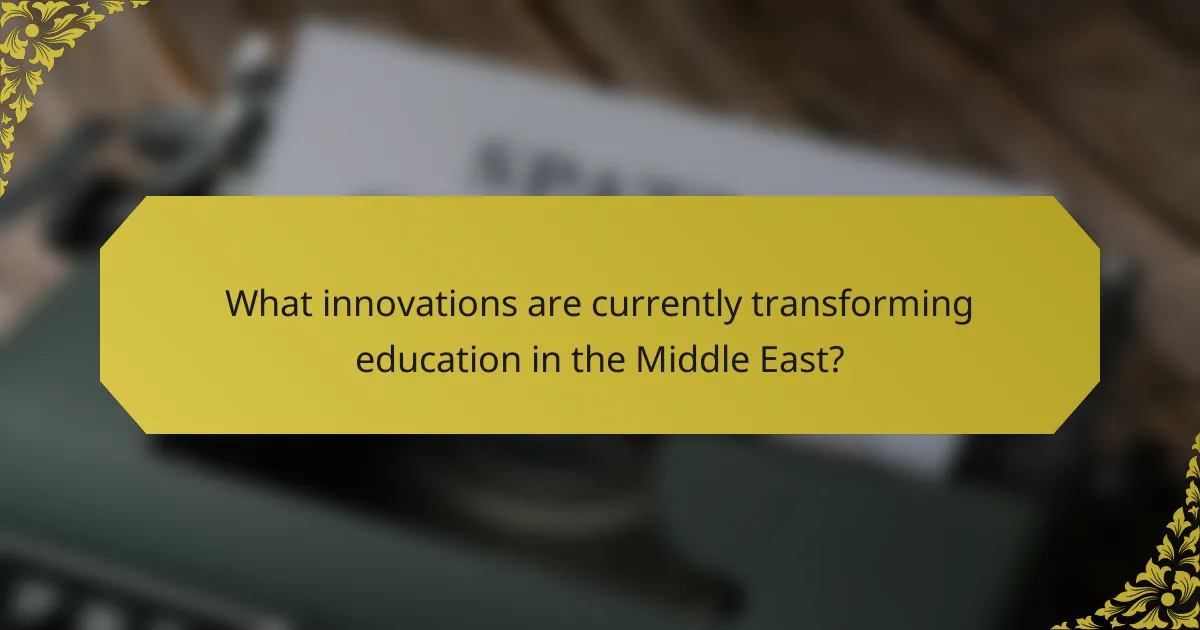
What innovations are currently transforming education in the Middle East?
Digital learning platforms are currently transforming education in the Middle East. These platforms enhance access to quality education for diverse populations. For instance, initiatives like the Arab Open University provide flexible learning options. Additionally, artificial intelligence is being integrated into educational tools. AI personalizes learning experiences and improves student engagement. Furthermore, blended learning models combine online and in-person instruction. This approach caters to various learning styles and needs. Governments are also investing in educational technology infrastructure. Reports indicate that these innovations lead to improved educational outcomes across the region.
How is technology being integrated into educational practices?
Technology is being integrated into educational practices through various methods. Schools are adopting digital learning platforms. These platforms facilitate online classes and interactive learning experiences. Smart classrooms utilize advanced tools like projectors and interactive whiteboards. Mobile devices are increasingly used for accessing educational resources. Virtual reality (VR) and augmented reality (AR) are enhancing experiential learning. Data analytics are being employed to track student performance and personalize learning. Research shows that technology can improve engagement and outcomes in education. For example, a study by the World Bank found that digital tools can boost learning in developing regions.
What are the benefits of e-learning platforms in the region?
E-learning platforms in the region offer increased accessibility to education. They allow learners to access courses from anywhere with an internet connection. This flexibility supports diverse learning styles and schedules. E-learning platforms often provide a wide range of subjects and resources. They can enhance engagement through interactive content and multimedia. Additionally, these platforms can reduce educational costs by eliminating travel and material expenses. According to a report by the World Bank, e-learning can improve educational outcomes, particularly in remote areas. This is crucial in the Middle East, where traditional education may face logistical challenges.
How do digital tools enhance student engagement and learning outcomes?
Digital tools enhance student engagement and learning outcomes by providing interactive and personalized learning experiences. These tools, such as educational apps and online platforms, foster active participation. They allow students to collaborate in real-time, facilitating better communication among peers. Studies show that gamified learning increases motivation, leading to improved retention of information. Furthermore, analytics from digital tools help educators tailor instruction to meet individual student needs. A report by the World Bank highlights that integrating technology in classrooms can boost academic performance by up to 30%. This data underscores the effectiveness of digital tools in enhancing educational experiences.
What role do international partnerships play in educational innovation?
International partnerships enhance educational innovation by facilitating resource sharing and knowledge exchange. They enable institutions to adopt best practices from global counterparts. Collaborative projects often lead to the development of cutting-edge curricula and teaching methodologies. For instance, partnerships with universities in developed countries can introduce advanced technologies in classrooms. Furthermore, these collaborations can attract funding and investment for educational initiatives. According to a report by the World Bank, countries that engage in international educational partnerships experience improved student outcomes. These partnerships also foster cultural exchange, enriching the educational experience for students and educators alike.
How are foreign educational institutions influencing local curricula?
Foreign educational institutions are influencing local curricula by introducing new teaching methodologies and content. These institutions often collaborate with local schools to develop programs that align with international standards. This collaboration can lead to the incorporation of global perspectives in subjects like science, technology, and languages. Additionally, foreign institutions may provide resources and training for local educators. Research shows that countries with partnerships with foreign universities often see improvements in educational quality. For instance, a study by the World Bank highlighted enhanced student performance in nations that adopted foreign curricula. Such influences help local institutions modernize and adapt to global educational trends.
What collaborative programs exist between Middle Eastern and Western universities?
Collaborative programs between Middle Eastern and Western universities include joint degree programs, research partnerships, and faculty exchange initiatives. For instance, institutions like the American University of Beirut collaborate with various U.S. universities for dual-degree offerings. The Qatar University partners with institutions like Texas A&M University for research in engineering and technology. Additionally, the UAE University has established partnerships with universities such as the University of California, Davis, focusing on environmental studies. These collaborations enhance academic exchange and research opportunities. They also promote cultural understanding and innovation in education.
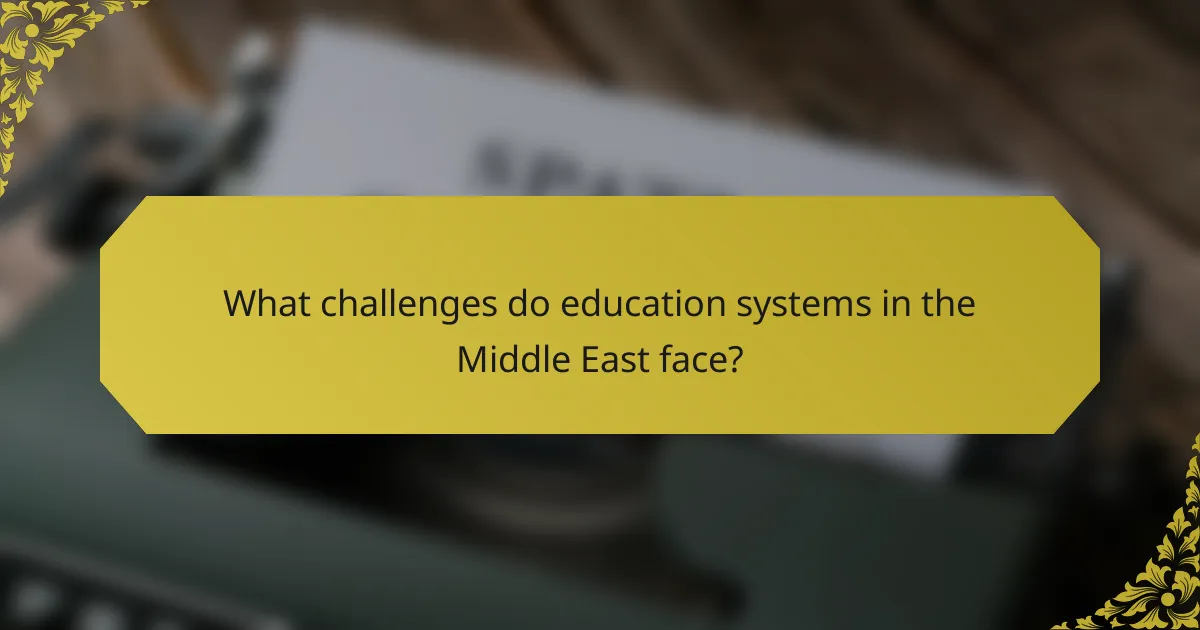
What challenges do education systems in the Middle East face?
Education systems in the Middle East face significant challenges. These include limited funding for educational resources. Many countries allocate less than 5% of their GDP to education. There is also a shortage of qualified teachers in various regions. High student-to-teacher ratios hinder effective learning. Additionally, political instability affects school operations and infrastructure. Conflicts disrupt education and displace students. Curriculum relevance is another issue, with a need for modernization. Lastly, access to education remains uneven, particularly in rural areas.
How does political instability impact education in the region?
Political instability significantly disrupts education in the region. It leads to school closures and reduced access to educational resources. In conflict areas, students often experience displacement, affecting their ability to attend school. Teachers may flee or become unavailable, resulting in a shortage of qualified staff. Curriculum implementation suffers due to a lack of stability and resources. According to a UNESCO report, over 13 million children in the Middle East are out of school due to conflict-related disruptions. Furthermore, political instability can undermine government funding for education, leading to deteriorating infrastructure. In summary, the impact of political instability on education includes school closures, teacher shortages, and reduced funding, severely affecting students’ learning opportunities.
What are the consequences of conflict on educational access and quality?
Conflict severely impacts educational access and quality. It disrupts schooling by damaging infrastructure and displacing students. According to UNESCO, over 75 million children are out of school in conflict-affected areas. This leads to increased dropout rates and lower enrollment numbers. Quality of education deteriorates due to a lack of trained teachers and resources. In war zones, students face psychological trauma, hindering their learning abilities. Additionally, curricula may shift to focus on conflict-related topics instead of standard education. Access to education becomes limited, particularly for girls, who are often more affected by conflict. These factors collectively contribute to a generation of youth with diminished educational opportunities and skills.
How do government policies affect educational reform efforts?
Government policies significantly influence educational reform efforts. They establish the framework within which reforms are developed and implemented. For example, policies can dictate funding allocations for schools and educational programs. This funding directly impacts resources available for reform initiatives. Additionally, government regulations can shape curriculum standards and teacher qualifications. Such regulations determine the quality and consistency of education across regions. Furthermore, policies can promote or hinder public-private partnerships in education. These partnerships often drive innovation and resource sharing. Historical evidence shows that countries with supportive educational policies see more successful reform outcomes. In contrast, restrictive policies can stifle progress and limit educational opportunities.
What issues exist regarding quality and equity in education?
Quality and equity in education face significant challenges. Disparities in resource allocation create unequal educational opportunities. Schools in affluent areas often receive more funding than those in low-income regions. This results in differences in teacher quality and access to learning materials. Additionally, socio-economic factors affect student performance and access to education. Marginalized groups, including refugees and girls, often experience barriers to quality education. The UNESCO report highlights that over 10 million children in the Middle East are out of school. This underscores the urgent need for equitable education reforms.
How do disparities in funding affect educational opportunities across different regions?
Disparities in funding create significant inequalities in educational opportunities across different regions. Schools in well-funded areas often have better resources, including advanced technology and qualified teachers. Conversely, underfunded regions struggle with outdated materials and overcrowded classrooms. Research indicates that students in high-poverty areas perform worse academically due to these funding gaps. For example, a report by the Education Trust shows that schools serving low-income students receive about $1,000 less per pupil than those serving wealthier populations. This lack of financial support leads to lower graduation rates and limited access to extracurricular activities. Ultimately, funding disparities perpetuate cycles of poverty and limit social mobility in affected regions.
What measures are being taken to promote inclusive education?
Measures to promote inclusive education include policy reforms and teacher training programs. Governments in the Middle East are implementing laws to support inclusive practices in schools. These laws aim to ensure access for all students, regardless of their abilities. Teacher training programs focus on equipping educators with skills to support diverse learners. Schools are adopting universal design principles to create accessible learning environments. Community awareness campaigns are also being launched to foster acceptance of all students. Collaboration with NGOs and international organizations helps to share best practices. Data from UNESCO indicates that inclusive education improves outcomes for all students.
What practical strategies can improve education systems in the Middle East?
Implementing teacher training programs can significantly enhance education systems in the Middle East. These programs should focus on modern pedagogical techniques and subject matter expertise. Investing in technology integration in classrooms can also improve learning outcomes. Access to digital resources and tools fosters interactive learning experiences. Curriculum reform is essential to align educational content with market needs. This ensures that students acquire relevant skills for future employment. Establishing partnerships with local industries can provide practical training opportunities. Finally, promoting community involvement in education can increase accountability and support. Research indicates that these strategies can lead to improved educational performance and student engagement.
Education systems in the Middle East are characterized by a blend of traditional practices and modern innovations, facing challenges such as funding disparities, political instability, and varying teacher qualifications. The article explores key attributes of these education systems, including the influence of cultural and religious factors, the integration of technology, and the impact of socio-economic conditions on access and quality. It also highlights historical developments, international partnerships, and specific strategies to promote inclusive education and improve overall educational outcomes in the region. Through this comprehensive examination, the article aims to provide insights into both the innovations transforming education and the persistent challenges that hinder progress.
